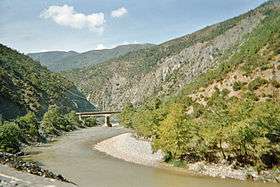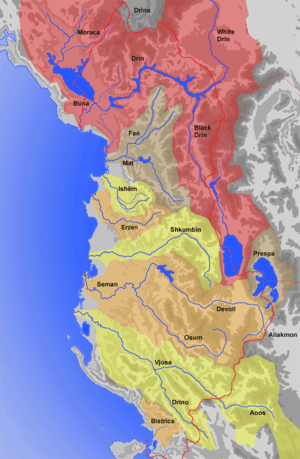Shkumbin
The Shkumbin (/ʃkuːmbiːn/; Albanian pronunciation: [ʃkumbin]; Latin: Genessus), also commonly Shkembi, is a river in Southern Europe.[4] It is 181 km (112 mi) long and its drainage basin is 2,444 km2 (944 sq mi). Its average discharge is 61.5 m3/s (2,170 cu ft/s).[5]
| Shkumbin | |
|---|---|
 | |
| Location | |
| Country | Albania |
| Physical characteristics | |
| Source | Valamara |
| • location | Korçë County |
| • coordinates | 40°47′57″N 20°18′14″E |
| • elevation | 2,120 m (6,960 ft) |
| Mouth | 18 km (11 mi) west of Rrogozhinë |
• location | Adriatic Sea |
• coordinates | 41°2′23″N 19°26′34″E |
• elevation | 0 m (0 ft) |
| Length | 181 km (112 mi)[1] |
| Basin size | 2,444 km2 (944 sq mi)[2][3] |
| Discharge | |
| • average | 61.5 m3/s (2,170 cu ft/s) |
Overview
The river originates in the eastern Valamara Mountains between Maja e Valamarës (2,375 m (7,792 ft)) and Gur i Topit (2,120 m (6,960 ft)) in Southeastern Albania.[6] After descending from the Valamara's, it flows northwards through Proptisht and Qukës with many deep gorges and canyons and passes the Gora Mountains. A significant inflow comes from Gur i Kamjës (1,481 m (4,859 ft)) southwest of Pogradec. Over the course, it flows inside a syncline between the Mokra and Shebenik Mountains in the east and the Polis Mountains in the west. Close to Librazhd the river turns some 50 km (31 mi) westwards of its origin and joins the Rapun stream.[7] At the end the river cross the Myzeqe Plain and forms a small delta in Karavasta Lagoon, the direct proximity of the Adriatic Sea.
Human history
The ancient name of the river was Genusus; its middle and upper valley was inhabited by the Illyrian tribe of the Parthini.[8][9] The ancient Via Egnatia followed the river, giving it the role of a strategically important corridor between orient and occident.[10]
The river is roughly the geographical dividing line between Tosk and Gheg Albanian dialects, with Gheg spoken north of the Shkumbin and Tosk south of it. The dialectal split occurred after Christianisation of the region (4th century AD) and at the time of the Slavic migration to the Balkans,[11][12] with the river as the historic dialectal boundary[13] which straddled the Jireček line.[14][15]
On various historical periods it was considered the northernmost natural boundary of Epirus,[16] while during the 5th and 6th centuries it was the cultural border between the Illyrian and the Greek world.[17] During this period the valley of Skumbin constituted roughly the border between the Latin and the Greek speaking area.[18]
 Hydrographic map of Albania: Shkumbin is shown in the center of the map. |
.jpg) Origin of the river at Valamara |
Shkumbin Valley about 5 km east of Elbasan |
See also
| Wikimedia Commons has media related to Shkumbin. |
- Geography of Albania
- Central Mountain Range
- Rivers of Albania
References
- "TREGUES SIPAS QARQEVE INDICATORS BY PREFECTURES" (PDF). Archived from the original (PDF) on 2011-07-24. Retrieved 2012-11-02.
- "The coastline of Albania : morphology, evolution and coastal management issues" (PDF). ciesm.org. p. 8.
- "Fishes from Shkumbini River (Central Albania): an ecological view". researchgate.net. p. 1.
- Fishta, Gjergj; Elsie, Robert (2005-10-04). Robert Elsie. p. 459. ISBN 9781845111182.
- Cullaj, A., Hasko, A., Miho, A., Schanz, F., Brandl, H. & Bachofen, R. (2005). "The quality of Albanian natural waters and the human impact". Environment International. 31 (1): 133–46. doi:10.1016/j.envint.2004.06.008. PMID 15607787.CS1 maint: uses authors parameter (link)
- University of Tirana. "Albert-Kurti-compressed.pdf" (PDF). doktoratura.unitir.edu.al (in Albanian). Tirana. p. 43.
- "KREU I: PASURITË UJORE SHQIPTARE" (PDF) (in Albanian). p. 19.
- Boardman, John; Edwards, I. E. S.; Hammond, N. G. L.; Sollberger, E. (1982). The Cambridge Ancient History. 3, Part 1: The Prehistory of the Balkans, the Middle East and the Aegean World, Tenth to Eighth Centuries BC. p. 629.
- Wilkes, J. J. (1995), The Illyrians, Oxford, United Kingdom: Blackwell Publishing, p. 93, ISBN 0-631-19807-5CS1 maint: ref=harv (link)
- University of Tirana. "MALLAKASTRA STUDIM GJEOGRAFIK" (PDF). doktoratura.unitir.edu.al (in Albanian). p. 21.
- Douglas Q. Adams (January 1997). Encyclopedia of Indo-European Culture. Taylor & Francis. pp. 9, 11. ISBN 978-1-884964-98-5.
- Indo-European language and culture: an introduction By Benjamin W. Fortson Edition: 5, illustrated Published by Wiley-Blackwell, 2004 ISBN 1-4051-0316-7, ISBN 978-1-4051-0316-9 (page 392)
- Concise Encyclopedia of Languages of the World By Keith Brown, Sarah Ogilvie Contributor Keith Brown, Sarah Ogilvie Edition: illustrated Published by Elsevier,2008 ISBN 0-08-087774-5, ISBN 978-0-08-087774-7 (page 23)
- Orel, Vladimir; Albanian Etymological Dictionary, Brill, 1998 ISBN 90 04 11024 0
- See also Hamp 1963.
- Mikropoulos A. Tassos.Elevating and Safeguarding Culture Using Tools of the Information Society: Dusty traces of the Muslim culture. Earthlab. ISBN 978-960-233-187-3, p. 320.
- Nicholas Geoffrey Lemprière Hammond. Migrations and invasions in Greece and adjacent areas. Noyes Press, 1976. ISBN 978-0-8155-5047-1. p. 54.
- J. j., Wilkes (1992). The Illyrians. B. Blackwell. p. 273. ISBN 0-631-19807-5.